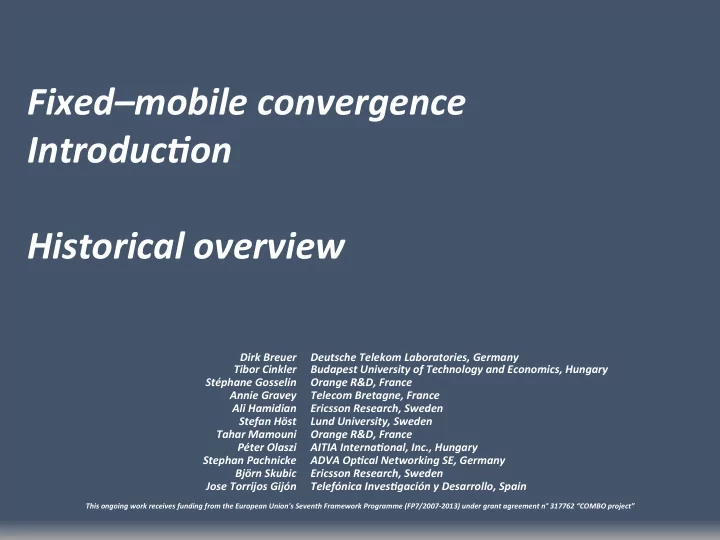

Fixed–mobile convergence IntroducSon Historical overview Dirk Breuer Deutsche Telekom Laboratories, Germany Tibor Cinkler Budapest University of Technology and Economics, Hungary Stéphane Gosselin Orange R&D, France Annie Gravey Telecom Bretagne, France Ali Hamidian Ericsson Research, Sweden Stefan Höst Lund University, Sweden Tahar Mamouni Orange R&D, France Péter Olaszi AITIA InternaSonal, Inc., Hungary Stephan Pachnicke ADVA OpScal Networking SE, Germany Björn Skubic Ericsson Research, Sweden Jose Torrijos Gijón Telefónica InvesSgación y Desarrollo, Spain This ongoing work receives funding from the European Union's Seventh Framework Programme (FP7/2007-2013) under grant agreement n° 317762 “COMBO project”
Fixed and Mobile Convergence: First wave • Originally: convergence of telephony voice services • Voice call redirec5on and seamless handover between Public Land Mobile Networks (PLMNs) and Public Switched Telephone Networks (PSTNs). • Mo5va5on: Reduce costs • Switching equipment CAPEX and OPEX is high • Fixed–mobile Convergence Alliance 2004–2010 • Founded in 2004, disbanded in 2010 • Consumers struggled to find a need for the technology • Intent to move to ‘ All IP ’ infrastructure • SIGTRAN protocol family: the ‘All IP’ version of the SS7 telephony signalling system • SCTP : Stream Control Transmission Protocol • Reliable, message-based protocol for signalling • complements UDP and TCP
Fixed and Mobile Convergence: Second wave • The communica5on landscape has transformed with the appearance of game-changers Smartphones (e.g. iPhone: 2007) and tablets • Cloud storage, so[ware as a service (e.g. Google Docs: 2007) • Social media (e.g. Myspace: 2003, Facebook: 2004, Twi^er: • 2006) Media sharing (e.g. YouTube: 2005) • • The focus shi;ed from voice to data • The volume of data increased drama5cally • Content delivery is important!
Fixed and Mobile Convergence: State of the art TISPAN: Telecoms and Internet converged Services and Protocols for • Advanced Networks Generic framework • IP MULTIMEDIA SUBSYSTEM (IMS) • Realised within the TISPAN framework • Put voice telephony to the Internet • Services, APIs, terminals • Some vendors: • CISCO: fixed–mobile convergence for voice • Google Fi: Over-the-top service using exis5ng mobile and Wi-Fi infrastructure • Swisscom: Mobile—Wi-Fi integrated services • Ap5lo: Wi-Fi authen5ca5on using mobile creden5als • Unlicensed mobile access • 3GPP + BBF + Wi-Fi Alliance are working closely • Ongoing work on EPS, 4G, 5G, Internet of things, machine-to- • machine communica5on, automo5ve communica5on
Presented by Annie Gravey annie.gravey@telecom-bretagne.eu Péter Olaszi peter.olaszi@aiSa.ai Björn Skubic bjorn.skubic@ericsson.com Dirk Breuer Deutsche Telekom Laboratories, Germany Tibor Cinkler Budapest University of Technology and Economics, Hungary Stéphane Gosselin Orange R&D, France Annie Gravey Telecom Bretagne, France Ali Hamidian Ericsson Research, Sweden Stefan Höst Lund University, Sweden Tahar Mamouni Orange R&D, France Péter Olaszi AITIA InternaSonal, Inc., Hungary Stephan Pachnicke ADVA OpScal Networking SE, Germany Björn Skubic Ericsson Research, Sweden Jose Torrijos Gijón Telefónica InvesSgación y Desarrollo, Spain This ongoing work receives funding from the European Union's Seventh Framework Programme (FP7/2007-2013) under grant agreement n° 317762 “COMBO project”
Recommend
More recommend